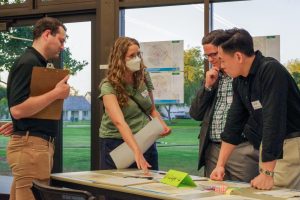The happiest place on earth lays off thousands
October 5, 2020
It was once regarded as the “happiest place on Earth,” one that drew in tourists from all over the world like moths to a flame. Chock-full of attractions, shows and rides, Disneyland caters to nearly 18.6 million people annually with a reputation as one of the most successful theme parks in the world. However, today it has been reduced to a grim reminder of just how destructive COVID-19 truly is.
It’s no surprise that social distancing guidelines have made sustaining the park, which requires large crowds to turn a profit, a nearly impossible task. A central part of the now staggering tourism industry, Disneyland remaining shut down comes with clear economic risks that far outweigh the benefits. California Governor Gavin Newsom should allow for the gradual reopening of theme parks with adequate safety measures in place.
In comparison to schools and small businesses, theme parks have been placed in the backburner in terms of reopening. For instance, schools reopened around August with social distancing maintained, and many small businesses have gradually reopened since September, if not earlier. In comparison, the majority of theme parks have remained closed since March.
A lack of guidelines have caused theme parks to suffer even further: The Walt Disney Company lost nearly $5 billion in the months of April, May and June alone after theme parks closed down. To compensate, Disneyland plans to layoff nearly 28,000 employees, including part-time workers, salaried workers and executives.
“We’ve cut expenses, suspended capital projects, furloughed our cast members while still paying benefits and modified our operations to run as efficiently as possible, however, we simply cannot responsibly stay fully staffed while operating at such limited capacity,” chairman of Disney Parks Josh D’Amaro said in a letter to employees.
This spells out danger not only for Disney itself, but also for California as a whole. According to an economic study at California State University in Fullerton, Disneyland generated $8.5 billion in economic activity for California in 2018 and created more than 78,000 jobs.
Disneyland’s reopening is also essential for the tourism industry, which is expected to lose $78.8 billion this year. Anaheim in particular relies on Disneyland to draw in tourists from around the world, both for Disneyland itself, and for Anaheim’s hotels, restaurants and other entertainment centers. The tourism industry has taken a large hit ever since Disneyland closed, and it is unlikely to recover for at least a few years.
In hindsight, Disneyland’s economic troubles that forced the layoff of nearly 28,000 employees was avoidable. California’s biggest failure? Miscommunication. The financial problems Disneyland faced were exacerbated by Newsom’s refusal to ease restrictions on theme park reopenings. The lack of guidelines and lack of any indication for when the park could reopen were particularly detrimental. Without any dates, it is difficult for Disneyland to plan for its reopening in hopes of getting back even a portion of the money they lost.
In September, Newsom promised that guidelines related to theme park reopening would be coming soon. However, at a press conference on Oct. 7, he changed course.
“There is no hurry in putting out guidelines… we don’t anticipate, in the immediate term, any of these larger theme parks opening until we see more stability in terms of the data,” Newsom said.
Many argue that Disneyland should remain closed in order to minimize social interaction and prevent the spread of COVID-19; however, there is no reason that Disneyland should remain closed when other places, most notably schools, are reopening. In fact, Disneyworld has been open in Florida since July with safety measures in place, and has experienced relative success. There have not been COVID-19 outbreaks connected to theme park reopenings thus far, and it is illogical to hold theme parks to a higher standard for reopening, when given sufficient health precautions, such parks should have no more risk than schools or offices.
“The State of California continues to…mandate arbitrary guidelines that it knows are unworkable and that hold us to a standard vastly different from other reopened businesses and state-operated facilities,” said Disneyland Resort president Ken Potrock in a statement.
Fortunately, an initial draft of guidelines for theme park reopenings was put out by Newsom in early October. Although it was a step in the right direction, it was far too restrictive to make tangible change. The guidelines called for reopening at 25% capacity, and only when the park’s county reaches California’s yellow tier, which requires less than one case per day per 100,000 residents and a testing positivity rate of less than 2%.
“We ask the Governor not to finalize guidance for amusement parks before engaging the industry in a more earnest manner, listening to park operators’ expertise and collaborating with the industry on a plan that will allow for amusement parks to reopen responsibly,” said California Attractions and Parks Association (CAPA) executive director Erin Guerrero in an official statement.
For the sake of the thousands of employees that work at Disneyland, and for the sake of California which so heavily relies on Disneyland, it is imperative that Disneyland be reopened. Maybe then, will Disney’s magic be finally restored.


























































